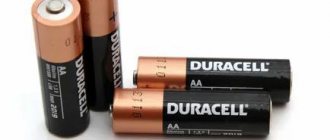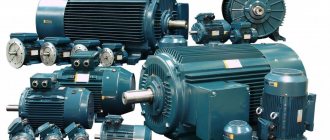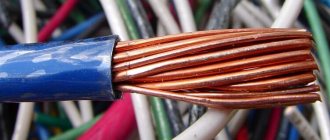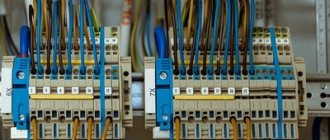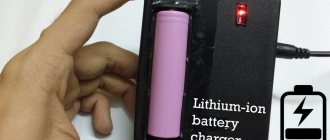AA batteries are a common type of voltaic battery and rechargeable battery. They are used as a source of energy in watches and radio-controlled models, electrical measuring instruments and flashlights, cameras, children's toys, remote controls, etc. There are two types: disposable and rechargeable, or rechargeable.
AA batteries.
Classification of batteries by size
The sizes and shape (standard size) are different, and this is the easiest way to distinguish products.
In this case, the chemical composition may be the same. Types of batteries by size: Classification by size.
- A. A cylindrical product with a height of 50 mm (including the contact surface) and a diameter of 17 mm. Today it is practically not used;
- AA. Also in the shape of a cylinder, another name is “finger”. Height – 50.5 mm, diameter – 14.5 mm. Used to power: remote controls, photographic equipment, flashlights, other lighting devices, etc.;
- AAA. It can be called “little finger”, as it is similar in shape to AA, only smaller. Height – 44.5 mm, diameter – 10.5 mm. It is used to power devices with low current consumption: remote controls, toys, FM radio, audio players, etc.;
- AAAA. Height – 42.5 mm, diameter – 8.3 mm. Occurs infrequently, mainly in devices with low current consumption, for example, tablet styluses;
- B. Height – 60 mm, diameter – 21.5 mm. It is used in dosimeters and chemical reconnaissance devices. Not relevant in everyday life;
- C. “Thumbelina” or “esque”, 50 mm high and 26 mm in diameter. In the USSR it was designated as 343. This size is suitable for powering: toys, flashlights, FM radio, musical instruments, etc.;
- D. A “barrel”, popular during Soviet times, whose height is 61.5 mm and diameter is 34.2 mm. It powered: radio tape recorders, walkie-talkies, Geiger counters, flashlights, watches, voltmeters, etc.;
- N. Height – 30.2 mm, diameter – 12 mm. Suitable for: laser pointers, microphones, doorbells;
- 1/2AA. Twice as shortened AA battery. Height – 25 mm, diameter – 14.5 mm;
- Crown. Usually this is a battery consisting of 6 other batteries, for example, AAAA size. A characteristic feature is a voltage of 9 V.
There are also miniature batteries, the diameter of which is 4.8 - 11.6 mm, and the height is up to 5.4 mm. Because of its flattened shape, the name “tablet” or “coin” came about. Typically used in wristwatches and other compact devices.
What is a crown?
Krona is a rectangular 9 volt battery with two poles at one of its ends. This element was created back in the Soviet Union, but is still popular. May be designated as PP3.
Is the crown a battery or an accumulator?
Initially, this element was produced as a simple battery. But with the development of technology, they began to produce rechargeable batteries of the Krona type. Therefore, there are both battery crowns and conventional ones. At the time of purchase, it is advisable to ask the seller what kind of energy source it is. You can also ask the question: “How many times can you recharge?”
On some of these batteries everything is already written.
The picture shows that it can be charged as many as 1000 times. But the usual crown is only 2 times. After which it may fail. Manufacturers do not recommend charging it.
Below are 6 pictures of 9v power supply.
Well, this is exactly what a crown battery looks like.
Why is the battery called crown?
It's difficult to answer this question exactly, but we can assume that it has something to do with her appearance. The crown is commonly referred to as the top of trees or a coin. And from here you can answer what the crown battery is called, or rather where it gets its name from.
The two upper poles can be compared to the upper branches of trees. There is a consonant word for crown. Perhaps this battery takes its name from this word. Because it vaguely resembles this item.
Once upon a time in the USSR there was a company called Krona that produced similar batteries. This company disappeared a long time ago, but its brand has taken root. And since then this battery began to be called that way.
The 9 volt battery is called “Krona” (PP3).
Distribution by form
Cylindrical batteries are the most common, but disk products are no less common. The classification according to form is as follows:
Classification by shape.
- R. From the English word “Round” - a round element. These are cylindrical models and “tablets”;
- P. Not round, rare;
- F. Flat, having a layer-by-layer structure;
- S. They look like a rectangular or prismatic platform.
Some products are available in every store, while others have to be looked for. Despite the abundance of options, they are classified according to standards. AA, AAA, B, C - the American standard, more familiar, so they usually adhere to it.
History of creation
These batteries have their own history of development. The battery as a voltaic cell became popular in the 1920s. But Georges Leclanche is considered its inventor - it was he who in 1867 created the prototype of the battery known to us. Of course, at that time the battery had a completely different look.
The Eveready company began mass-producing them for consumers. At first, the company's focus was on owners of radios, but soon the new product was appreciated by workers in mines, enterprises, and sailors.
In 1920, the well-known Duracell company appeared on the market and began producing various batteries, which were especially popular. They have become more compact, lighter and, most importantly, cheaper. They consisted of a graphite rod, manganese oxide and a zinc cup. The operating principle was based on the occurrence of an electrical impulse.
Due to the presence of a graphite rod, manganese-zinc batteries were sometimes called carbon-zinc batteries. Over the entire history of their existence, such batteries have been improved and have undergone many changes and innovations. At the moment they can be found in any store. And carbon batteries were replaced by others, as described below.
Types by chemical composition
Depending on what the batteries are made of, according to the international IEC standard, they are marked as follows:
- R—salt;
- LR - alkaline;
- SR - silver;
- CR - lithium;
- PR - zinc air.
Each type of battery has pros and cons.
Salt
They are easy to distinguish by price, because they are the cheapest. The market includes Sony, Toshiba. They are advanced manganese-zinc batteries. It is advisable to use it in devices with low voltage consumption: watches, scales, remote controls.
They discharge quickly and cannot be recharged. During prolonged use, the galvanic cell may leak. At sub-zero temperatures, salt batteries stop working. Despite many shortcomings, this product is in demand on the market.
Alkaline (alkaline)
Galvanic cells of this type first appeared in 1964. They were then produced by Duracell.
If we consider all chemical food sources, alkaline ones are now the most in demand. The cathode material is zinc, and the anode is manganese dioxide. Alkaline electrolyte – potassium hydroxide (gel-like substance).
We recommend reading: How to measure resistance with a multimeter: instructions, photos, videos
Alkaline battery device.
Compared to salt products, alkaline products are characterized by increased energy intensity and are able to operate at sub-zero temperatures, down to -20°. Their shelf life is 7–10 years, which can be achieved due to low self-discharge. The voltage setting is 1.5 V. The price is a little more expensive than salt ones. There are rechargeable varieties.
Alkaline cells are used for devices with medium or high current consumption: in photographic equipment, audio players, children's toys.
Mercury batteries
Not widely used due to high cost and increased toxicity. After all, they can leak, and mercury is dangerous for humans. But such a galvanic cell can be recharged several times. Although over time its capacity is lost - due to the fact that mercury flows down and collects in drops inside the battery.
The advantages of these products include good uninterrupted operation in harsh atmospheric conditions and a long shelf life.
Nickel-cadmium (Ni-Cd)
Invented at the end of the 19th century in Sweden by engineer Waldemar Jungner.
These are rechargeable power supplies with an anode made of cadmium oxide hydrate and a cathode made of nickel oxide hydrate. The electrolyte is potassium hydroxide, to which LiOH (lithium hydroxide) is added. The shapes are flat, cubic, cylindrical, always with a sealed body.
The voltage is about 1.35 V. Their service life is from 100 to 900 charge-discharge cycles (depending on the design, quality of materials used, operating mode). Lamellar nickel-cadmium batteries used in industry last 20–25 years. Like nickel-salt, they can be stored in a discharged state. A special feature is low resistance, so it does not heat up during charging, even with high currents. It starts to heat up only when the charge is completely restored.
Nickel-cadmium batteries are rarely used for environmental reasons, and then mainly where other systems are not suitable. Usually this is powering devices characterized by high discharge and charging currents.
Nickel-cadmium batteries.
Pros:
- operating temperature range – from -50 to +40°;
- stored unloaded for a long time;
- life time;
- work stably in the cold, without reducing energy intensity (to reasonable limits);
- safe when depressurized, at least they don’t catch fire like lithium ones;
- availability.
Minuses:
- high self-discharge (some models lose 10% per day, others the same amount per month);
- if stored without use for a long time, the charge must be restored according to a certain algorithm;
- due to the “memory effect” they require complete discharge;
- Low energy consumption compared to other batteries.
Cadmium is a toxic material, so some countries have banned the manufacture of Ni-Cd batteries. It is prohibited to dispose of used products - they are handed over to special points for subsequent recycling.
Nickel metal hydride (Ni-Mh)
Nickel metal hydride batteries.
Also, rechargeable batteries are in demand in areas where long-term charge retention is required. They are popular due to their high energy intensity and environmental friendliness of materials, which simplifies disposal.
The cathode is nickel oxide, the anode is a hydrogen metal hydride electrode. They began to be developed in the mid-twentieth century, as a replacement for nickel-cadmium batteries. Today, alloys and metals are being improved, and modern Ni-Mh batteries can withstand up to 2000 charge-discharge cycles.
There are two groups on the market:
- 1500 – capacity 3000 mAh. For devices with high energy consumption in a short period of time: photographic equipment, audio players and other gadgets;
- 300 – 1000 mAh. For those devices where energy is consumed after a time interval: toys, walkie-talkies, navigators and other devices that operate autonomously.
They serve on average 1 – 5 years. The self-discharge characteristic is 30% per month, which is quite a large figure, and at room temperature. Operating temperature – from -20 to +60°.
We recommend reading: LM358 microcircuit: datasheet in Russian, application, analogues, pin assignments
Pros:
- environmental friendliness (fewer harmful substances in the design than analogues);
- increased energy intensity;
- without “memory effect” (does not require complete discharge).
Minuses:
- after 300 charge-discharge cycles, the capacity drops;
- may catch fire;
- increased self-discharge.
These batteries have proven themselves best for devices with high energy consumption in a short period of time.
Lithium-ion (Li-Ion)
The cathode is lithium, the anode is manganese dioxide, carbon monofluoride or other materials. Electrolyte – organic.
Lithium-ion battery device.
Features of these elements: increased energy intensity, shelf life reaching 12 years, low weight, stable voltage.
Lithium batteries are used in powerful devices with long-term operation: photographic equipment, portable speakers, medical equipment, smartphones, etc.
There are also iodine-lithium cells in which lithium serves as a reducing agent and iodine as an oxidizing agent. These are powerful batteries that last a long time and drain slowly.
Also classified as lithium are products that have a solid cathode. The anode material in this case is metal sulfides and oxides. Salt solutions serve as electrolytes. Capacitive batteries that operate in a wide temperature range, but expensive.
Pros:
- compact;
- different voltage parameter;
- shelf life;
- resistant to temperature changes.
Their disadvantage is their high price.
Silver
They work in a similar way to mercury batteries. There is only one drawback - the very high cost. But at the same time, their capacity is 30-50% greater than that of lithium batteries. Silver batteries work well at high and low temperatures and have a long service life.
Zinc air
This type of battery is very sensitive to external factors, such as humidity and air temperature, so they are recommended for use indoors. Positive properties - large capacity and environmental friendliness. Once opened, the packaging can last no more than one month.
The cost of these devices cannot be ignored. Silver, lithium and alkaline batteries are expensive, but they can last for a long time. If they are used correctly, they can pay for themselves several times over, while salt batteries will literally fail in a short time.
- You should also take a closer look at the packaging and battery manufacturer. In most cases, manufacturers always mark the battery housing so that the buyer can determine the type of electrolyte.
- When selecting a battery, it is necessary to take into account that under different loads it will behave completely differently. In addition, the functionality will be influenced by the environment. So in winter, but in the cold, the electrical conductivity of the electrolyte will deteriorate, as a result of which its capacity will also decrease.
- It is necessary to take into account the fact that when batteries are stored for a long time, they can lose about 30% of their initial capacity. Therefore, it is recommended to take a close look at the production date. You should know that domestic manufacturers mark the date of manufacture, and foreign manufacturers indicate the last date of use of the battery.
- It is necessary to carefully inspect the elements of the device to ensure that there are no defects that could reduce the efficiency of operation.
- When selecting power supplies for a specific device, it is necessary to take into account the dimensions of the mounting space for them; it can vary. For example, a remote control will require little finger batteries, and for some player you will have to purchase finger batteries. For electronic scales, hearing aids or other small devices, you will need to buy button batteries. In this case, it is necessary to take into account the markings, thickness and diameter of the “tablet” so that it is suitable for a specific device.
Ni-MH batteries.
Batteries were tested . Now their cost is about $3-5, that is, comparable to lithium batteries. Ni-MH batteries have a significant drawback - high self-discharge current. In a week their charge drops by 10-20%, in a month by 30%, in a year - to zero. Therefore, it makes no sense to use them for low currents with a long discharge time. But now a new generation of Ni-MH batteries has appeared - the so-called Ready-to-Use. They have a low self-discharge current and are sold already charged. Over the course of a year, such cells lose only 15-30% of their charge. There are 3 such batteries involved in the test, and they are highlighted below in a separate group.
when the temperature is -15, the capacity drops by 30%, and batteries also deteriorate when charged in the cold.
Operating and storage conditions:
— do not subject to deep discharge (keep the charge at least 20%);
— do not leave a discharged battery for long-term storage.
— do not expose to temperatures below -20°C and elevated temperatures;
- store and use at room temperature.
What types of C-type batteries are there?
C-type products (cylinder-shaped) are saline, alkaline, and nickel-metal hydride.
C-R14
These are salt power sources and cannot be recharged. They are inexpensive, their voltage is 1.5V. According to ANSI standards they are designated as 14D. They weigh little and have small operating parameters.
We recommend reading: Pinout of different types of USB connectors: pinout of micro and mini usb, pinout features
Suitable for equipment with low power consumption - up to 200-400mA. They are recommended to be used only at comfortable (plus) temperatures. In the cold they lose their properties.
C-LR14
Alkaline batteries with a power of 1.5V. Their cost is 2-3 times higher than salt ones. At the same time, their volume is 7-10 times larger, and their service life is five times longer.
14A is the ANSI designation. It weighs a little more than salt products. They can supply power to the device for a couple of days with a power of up to 400-500mA. Or a couple of hours of equipment with a power of up to 1-2A. Their temperature range is much wider.
C-HR14
This product is a nickel metal hydride battery. It can be charged. Has a higher cost than previous models. Has the following parameters:
When compared with nickel-cadmium elements, these have improved performance. If used correctly, they will last for many years.
Mistake #9 – Resistance measurement
Very often, using a multimeter, we need to find out what resistance a particular circuit element, section of a circuit, or some device has. This is done in resistance measurement mode (Ohm, miOhm, microOhm, etc.).
When taking this measurement, never touch the tips of the probes with your bare hands!
Our body has its own resistance (up to 10 kOhm), and in this case it will introduce an error into the measurement results.
The same applies to resistance measurements inside circuits, without soldering the elements. The resistance of adjacent parts can significantly distort the data.
Also, the error can be caused by the cheap device itself and its thin wires with probes. This happens when measuring with small resistances.
Here, for example, are the results of testing a small resistance (3 ohms) with a good multimeter.
But this is the result of the same resistance on the cheap DT830B.
To get a more accurate result on cheap models, always connect the probe wires to each other before measuring and look at the readings on the display.
It is these numbers that you will have to subtract in subsequent measurements with other parts and elements of the chain.
Advantages and disadvantages
The advantages and disadvantages of cells vary greatly depending on the chemical type of the "C" cell. The most noticeable disadvantages can be found in the following batteries:
- Battery salts may leak, causing a short circuit on the electrical board and corroding the electrical paths.
- Lithium batteries and batteries may explode.
- Alkaline batteries have significant weight, which is especially noticeable when several batteries of this type are installed in the device holder.
- Nickel-metal hydride products have a fairly high level of self-discharge.
A significant disadvantage may be the cost of current sources of standard size “C”. In this parameter, lithium batteries are significantly inferior, the price of which can differ by several dozen times, compared to the cheapest products.
Positive characteristics of batteries can be:
- Low cost when purchasing saline ones.
- Alkaline elements have a significant reserve of electricity.
- Resistance to heavy loads and environmental safety of nickel-metal hydride products.
- Lithium batteries have a long service life.
The ability to operate at negative air temperatures can also be considered as a positive feature of the current source. According to this indicator, lithium batteries have performed well.
Is it possible to charge
If the battery is a type “C” battery, this means that its charge can be restored by installing it in the holder of a special device. It is almost impossible to revive a salt or alkaline battery in this way.
Violation of instructions for the safe use of galvanic cells can lead to explosive depressurization of the product.
If the battery discharge has reached a critical level, it should be removed from the device and replaced with a new product or a rechargeable battery.
Application area
The scope of use of batteries and accumulators of type “C” is very wide. Portable power sources are used in devices that require increased power consumption.
In addition, such batteries can be installed in series, so they can be used to ensure the functionality of devices that require a significantly higher voltage to operate than 1.5 or 3.7 Volts.
Most often, power sources of this type can be found in the battery compartments of the following devices:
- Radio receivers.
- Lanterns.
- Measuring instruments.
- Children's toys.
Batteries can be type “C” and can be installed not only in portable devices, but also in permanently located household appliances. For example, with the help of one or two batteries, fuel can be ignited in gas stoves or water heaters.
Charger
Devices designed for recharging batteries restore energy capacity and allow the power source to be used repeatedly. Chargers can be classified into 2 types:
- simple;
- universal.
The first chargers perform only recharging. Universal allow:
- determine the current strength independently or automatically;
- protect the device from overheating;
- after purchasing a new battery, perform a couple of discharge and charge cycles;
- make sure the elements are working;
- detect one-time sources;
- use the screen to report on completed work;
- independently program the operation of the product;
- turn off the device using a timer or in automatic mode;
- operate with several types of batteries;
- use in the car using a special adapter.
Manufacturers
The following companies produce similar batteries:
- Panasonic ni mh hhr 55aaab.
- Duracell aaa.
- Trophy.
- Philips.
- Pleomax.
- Xiaomi.
- .
- Philips.
- FinePower.
- Energizer.
- Robition.
- Minamoto.
- Space.
- Varta.
- Canyon.
- Bison
Mistake #1 – Measuring current in a socket
How to measure the current in an outlet and find out if it really corresponds to its declared characteristics (6A or 16A)? Like you stuck the probes in, and the device shows you Amperes.
The answer is no. The only thing that can be measured in an outlet with a multimeter is the alternating voltage.
Never insert probes into sockets with the mode switch set to the “current measurement” position!
Yes, sometimes a multimeter is used to check the continuity of the circuit in the socket or the presence of a short circuit in the electrical wiring, by testing and checking the resistance of the incoming cable.
But for this, not only the automatic sockets, but also the input switch must be turned off in the electrical panel.
In all other cases, “how much current is in the outlet” you will not know. Just check how well the protection works in your electrical panel.
Here are the visual consequences of such measurements on the tips of the probes that were inserted into the socket to check the current strength. The current turned out to be stronger
And these are the consequences inside the multimeter itself.
Pay special attention - most cheap Chinese multimeters do not measure alternating current at all! This is indicated by the inscriptions on the case. Near the connectors for the probes, where it says 200mA and 10A, there is a straight (-) or intermittent dotted icon (
.) lines. It means that this multimeter can only measure DC OR PULSATING CURRENT (from a battery, accumulator, power supply, etc.)
Near the connectors for the probes, where 200mA and 10A are written, a straight (-) or broken dotted (...) line icon is drawn. It means that this multimeter can only measure DC OR PULSATING CURRENT (from a battery, accumulator, power supply, etc.)
Sockets and household appliances are out of the question here! “Recess” is indicated by a wavy line (~).
The easiest way to make a load fork
In order to make the simplest fork and immediately take the necessary readings, you will need the following available tools and actions:
- Any spiral. You can take a good-quality spiral from an old electric stove lying around in the garage.
- The spiral should be rolled into several layers (wire strands), achieving a resistance value of 0.1-0.15 Ohm.
- You need to take the battery itself (with a voltage of up to 15 V), a car light bulb (for example, remove it from the turn signals, with a power of 21 W). Such a homemade resistance can either be soldered or secured with a screw and nut. You will also need a multimeter with a current range of 10 amps.
- The entire circuit is assembled and connected in series.
- Then the clamps are brought out to the battery terminals.
- The multimeter provides readings of the current flowing through the circuit. The usual indicator in this case is ±1.78 A.
- Now we remove the multimeter and turn on the entire circuit again.
- Using it, we take readings of the voltage on the spiral, which is twisted in several layers. Here the indicator will be in millivolts, about 197 mV.
- We calculate the required resistance according to Ohm's law - 0.197: 1.78 = 0.11 Ohm.
Thus, the resistance of our homemade resistor is 0.11 Ohms. Now you need to connect it to the battery for 5-10 seconds with a multimeter connected to it, which will measure voltage readings in the constant 20 volt range. We take readings and record them. A self-made load fork works well if the chain was assembled correctly.
Determination of current strength
This method is usually used to determine the power of a power supply element. You can also use it to check the performance of a used battery. The multimeter must first be configured so that the device displays a DC current reading.
The verification algorithm is standard. The multimeter probes are connected to the plus and minus of the battery. The measurement lasts 2–3 seconds. The optimal current value is 4–6 amperes. If the result is lower when assessed with a multimeter, this indicates that the battery life is reduced. At 3–3.9 amperes, the battery can be used for undemanding electrical appliances.
